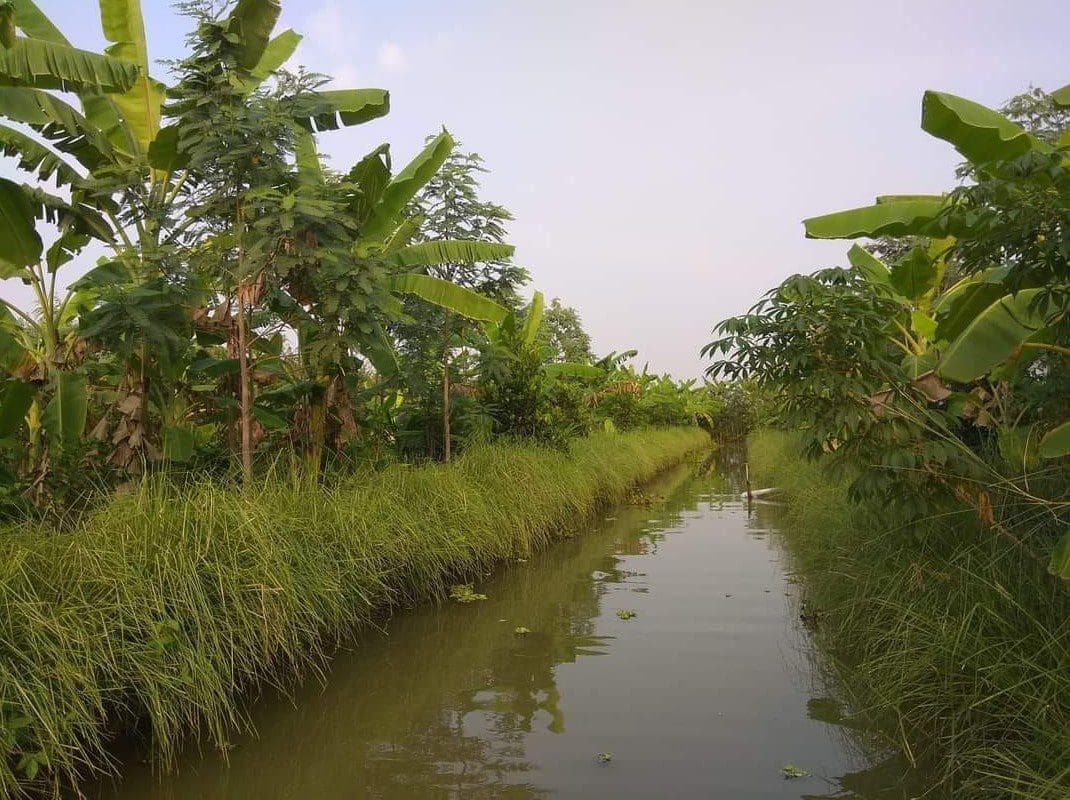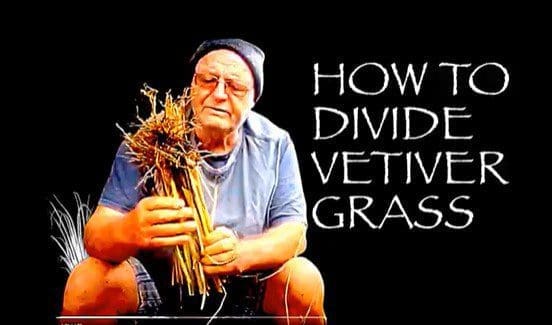
Climate Change
Current, climate change related, extreme drought, heatwave and flood events are having a devasting impact on us all. The agricultural sector is especially impacted, particularly small and vulnerable farmers. The Vetiver System can help prevent/reduce some of the negative impacts of climate change if applied prior to the event; and can be used to mitigate some of the damage after the event. It is important to remind ourselves what the Vetiver System can do for the agricultural sector….…. Vetiver hedges will reduce the impact of flood damage by slowing and spreading out the flow of water, improving infiltration and groundwater recharge, reducing field erosion, downstream sedimentation and fertility losses; as a mulch, reduce soil temperatures and conserving soil moisture, thus extending the time to plant wilting – often the difference between total crop loss and crop survival. Weakened crops often lead to greater pest damage – vetiver, in some instances, will mitigate the latter.

Our cover photo from Ngo Duc Tho (Vietnam) shows how vetiver in recent years can be used to rehabilitate a sand “desert”. Twenty years ago, Paul Truong and some commercial farmers planted (as part of the Land Care program) vetiver on the heavy, black cracking, flood prone vertisols of Queensland’s Darling Downs … the vetiver hedgerows reduced rainfall runoff and flood water velocity, improved drainage at the hedge line and prevented erosion. Graham Dabbs (Zimbabwe) is currently using vetiver for the same purpose as the Darling Downs application in support of small African farmers. Small farmers on all the continents are using vetiver to protect their land and crops against more frequent extreme events.

Some of the infrastructure that supports these farms, such as farm to market roads, irrigation canals and drains, will all come under greater damage risk due to extreme weather events. The Vetiver System can significantly reduce damage to such structures if designed and applied correctly. Encourage your local authorities to consider using low-cost vetiver solutions to protect their communities while at the same time reducing investment and maintenance costs and providing increased employment opportunities for both those who propagate vetiver and those that apply it.
From Chile – Pablo Molina (who has been working with vetiver for some 20 years) writes:
“In Chile there is a growing interest in vetiver. I am currently delivering plants to all parts of Chile for different uses. People mainly need vetiver for slope control and water decontamination. Currently, the Ministry of Agriculture has incorporated within its guidelines the need to develop agroecology; and government institutions have committed to the development of technologies for the benefit of the environment and sustainable practices. I am currently in talks with INIA (National Institute of Agricultural Research of Chile) to develop a vetiver project for the control of strawberry nematode. I hope that these meetings are successful and will lead to important research for the control of this pest that causes multimillion-dollar losses throughout the world. This could be a gateway for new vetiver research in Chile”
News from our Facebook page:
Over the past few weeks there has been some lively discussion about the optimum size of container propagated containers…lots of responses to Jannie Pretorius’ (South Africa) original question. There are many different types of containers used. All are effective – some more economic than others! More importantly, in the light of the extra expense over bare-rooted plants, is when to use containerized plants? In general use them when there may be a need to protect very high-cost infrastructure under difficult planting conditions (extreme dry or wet conditions) when a 100% survival rate combined with quick establishment is required. Whilst on the topic of propagation as the demand for VS applications increase there will be a need for more nurseries both very large, large and small. Lots of opportunities here. Note that you can register your nursery with TVNI and have its coordinates included under the plant suppliers list.

I love reading Dave Riley’s posts. His kitchen garden always looks so wild and “messy” but he achieves excellent results when embedding vetiver into his garden and in close proximity (planting vetiver 1.5 m apart) to his vegetables, using it for soil fertility improvement, and as a mulch and pathway in combination (the thick mulch appears to prevent soil compaction). Dave is a nurseryman and often has interesting questions and observations – you can read more of his posts here.
Jaimie Calderas has posted another of his very useful Videos. This one, set to a very cheerful tune, shows the range of vetiver applications (text and images). Could be useful for the general promotion of the Vetiver System – unless you are a very fast reader, its best to pause the text.
We have many members of our Facebook group and visitors to the website from India. Their numbers are increasing, as are their very useful contributions, observations, and comments. Sourav Mondal posted photos of vetiver used to successfully stabilize railroad embankments in Haryana, an extremely hot (40°C +) and dry state in India’s northwest. Apart from the location and climate, it is interesting to note that Indian Railways included vetiver in its railway guidelines nearly 20 years ago. The Konkan Railway that services India’s Western Ghats also uses vetiver for railbed and cutting stabilization. Himkar Mishra from Shail Natural Farms (Ramnagar, Bihar, India) posts regularly about his use of vetiver. It would be nice to see if he could apply vetiver to his rice fields and fishponds and record the impact. A couple of videos posted by Lakhvinder Singh show vetiver leaves and stems being cut by a three-point linked, tractor mounted sickle bar mower (that may have been modified) and a vetiver root digger/harvester. The latter looks as though it may have been adapted from an ancient beet harvester. It appears to leave a lot of unharvestable root in the ground to the benefit of the soil. In the event that demand for vetiver plant material surges some of these commercial vetiver oil produces could be in a position to supply millions of vetiver slips as a biproduct of root harvesting for oil – sacrificing 5% of the root (the portion attached to the crown) harvested for oil mighty give a much greater return as a marketable planting material (slip) than extraction of oil. An interesting research topic would be to (1) determining the percentage of the total vetiver root mass remaining in the soil after root harvesting for oil and (2) the soil organic carbon increase created by the remaining root mass, and (3) the potential impact on various follow up crops if the vetiver fields were rotated (e.g. soil fertility/structure improvement, nematode reduction). There are many vetiver oil producers in India – may I suggest that you persuade your local authorities (particularly PWD) to use vetiver grass for infrastructure roads, water, and pollution control. Good for the communities, your business and the environment
Seventh International Vetiver Conference (ICV7).
The Royal Development Projects Board has informed us that ICV7 is planned for May 2023. Confirmation is expected soon and details will be set out on the conference website at: The Seventh International Conference on Vetiver (ICV-7) . NOTE: The conference will be for in-person and online participation (including the field visits). This will allow many who cannot afford to attend to participate fully.
Caribbean Green Infrastructure Conference.
Trinidad and Tobago’s IAMovement will co-host with the National Gas Company of Trinidad & Tobago (NGC), (with some financial and technical support from the Inter-American Development Bank), a hybrid in-person and online participation conference on 18th and 19th October, 2022. This conference with the Vetiver System at its center should be of interest to Caribbean nations as well others in the region.
The Vetiver Short Video Competition.
Thus far we have 14 registered as participants. We had hoped for more than 30 by August 31 deadline. To enable those who may not have had time to make their video we have decided to extend the closing date for submissions to October 31 2022 (response has been very positive to the deadline change). We encourage you to participate as every video will be of value to those who view it, and there is a chance you might win A CASH AWARD. The competition provides an opportunity for you or your organization/company to show its vetiver work. See details for the competition . All videos, should be electronically delivered to Office of Royal Development Projects Board (ORDPB) [email protected] by either email or a Google Drive link share to [email protected]
Vetiver System location program
(The Vetiver System · iNaturalist ) – This project initiated by Eric Wiediger is continuing and it is nice to see that additional vetiver locations continue to be added. We encourage all vetiver users to locate their plantings on this site. Not only does it benefit other active vetiver users, researchers, and planners, but it also is of great interest to many naturalists around the world. So please find time to participate.
1,000 Vetiver documents added to TVNI website.
Dr Paul Truong, TVNI Technical Director, has kindly added his collection of vetiver documents (research papers, articles, presentations, photo essays etc.) to our website. They are located and are available to the public on Google Drive at: 1-New Papers – Paul Truong 08-2022 – Google Drive. The broad content subjects are at: LIBRARY.docx – Google Docs (at this time not linked to the individual papers). The contents include:
| 0. VETIVER PLANT- 37
1 Vetiver -36 2 Other Organisms -1
|
1. SOIL CON – 90
1 Vetiver -44 2 Other Organisms -12 3 General-34 |
2. PHYTOREMEDIATION GENERAL- 70
1 Vetiver-9 2 Other Plant -6 3 General-55 |
| 3. PHYTOREMEDIATION WATER- 110
1 Vetiver -79 2 Other Organisms -17 3 General-14
|
4. PHYTOREMEDIATION CONSTRUCTED WETLAND -97
1 Vetiver -22 2 Other Organisms -16 3 General-59 |
5. PHYTOREMEDIATION LANDFILL-12
1 Vetiver -4 2 Other Organisms -0 3 General-8
|
| 6. PHYTOREMEDIATION FLOATING ISLAND-19
1 Vetiver -12 2 Other Organisms -1 3 General-6 |
7. PHYTOREMEDIATION LAND-92
1 Vetiver -55 2 Other Organisms -12 3 General-25 |
8. MINE REHAHABILITATION- 106
1 Vetiver – 68 2 Other Organisms -8 3 General-30 |
| 9. PHYTOREMEDIATION ORGANICS-42
1 Vetiver – 29 2 Other Organisms -4 3 General-9 |
10. BIOENGINEERING-74
1 Land Slope -35 2 Stream bank-32 3 General- 7
|
11. PEST CONTROL-16
1 Rice Stem Borer 12 2 Other Pests 4
|
| 12. SEQUESTRATION-15
1 General-4 2 Vetiver -11 |
13. GENETICS-5
1 Vetiver -4 2 General-1 |
14. MEDICINAL-9
1 Vetiver -8 2 Other Organisms -1 |
| 15. ESSENTIAL OIL-4
1 Extraction of oil
|
16. MICRO ORG + MYCORRHIZA 14
1 Mycorrhiza 9 2 Microbes 5 |
17. AGRO FORESTRY 11
1 Fiji 4 2 Other Countries 4 3 General 3 |
| 18. SELECTED RELEVENT PAPERS 199
1 Vetiver -18 2 Other Organisms -8 3 General-30 4 PT Publications 143 |
TOTAL – 1,021
|
Hello.
The sentence ‘In the event that demand for vetiver plant material surges some of these commercial vetiver oil produces could be in a position to supply millions of vetiver slips as a biproduct of root harvesting for oil – sacrificing 5% of the root (the portion attached to the crown) harvested for oil mighty give a much greater return as a marketable planting material (slip) than extraction of oil’ in the above article (section on India) seems to have a stray link.
Best Regards.
Thank you, I wonder how that git in, I certainly did not include it! Have deleted. I appreciate your thoroughness.